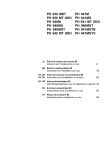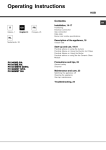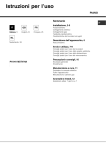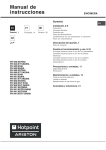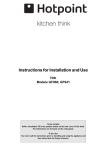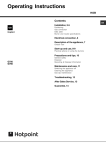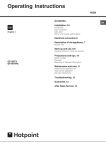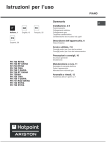Download Ariston PH 9 Hobs Operating instructions
Transcript
Operating Instructions HOB Contents GB English,1 PT FR Français, 13 AR Português, 40 ES Español, 27 Installation, 2-5 Positioning Electrical connection Gas connection Data plate Burner and nozzle specifications Description of the appliance, 6 Overall view Start-up and use, 7-9 Practical Practical Practical Practical Module PH 930MST PH 940MST PH 941MS PH 941MSTB PH 941MSTB GH PH 941MSTV PH 941MSTV GH PH 960MST PH 960MST GH advice on using the burners Advice on Using the Electric Hot Plates Advise on Using the Broiler advice on using the the Ceramic Glass Precautions and tips, 10 General safety Disposal Maintenance and care, 11 Switching the appliance off Cleaning the appliance Gas tap maintenance Troubleshooting, 12 GB Installation ! Before operating your new appliance please read this instruction booklet carefully. It contains important information for safe use, installation and care of the appliance. also be equipped with vents to allow gas to escape in the event of a leak. As a result LPG cylinders, whether partially or completely full, must not be installed or stored in rooms or storage areas that are below ground level (cellars, etc.). It is advisable to keep only the cylinder being used in the room, positioned so that it is not subject to heat produced by external sources (ovens, fireplaces, stoves, etc. ) which could raise the temperature of the cylinder above 50°C. ! Please keep these operating instructions for future reference. Pass them on to possible new owners of the appliance. Positioning ! The appliance must be installed by a qualified professional according to the instructions provided. Incorrect installation may cause harm to people and animals or may damage property. ! This unit may be installed and used only in permanently ventilated rooms in accordance with British Standard Codes Of Practice: B.S. 6172 / B.S. 5440, Par. 2 and B.S. 6891 Current Editions. The following requirements must be observed: • The room must be equipped with an air extraction system that expels any combustion fumes. This may consist of a hood or an electric fan that automatically starts each time the appliance is switched on. Fitting the appliance Gas and mixed hobs are manufactured with type X degree protection against overheating. The following precautions must be taken when installing the hob: • Kitchen cabinets adjacent to the appliance and taller than the top of the hob must be at least 600 mm from the edge of the hob. • Hoods must be installed according to their relative installation instruction manuals and at a minimum distance of 650 mm from the hob. • Place the wall cabinets adjacent to the hood at a minimum height of 420 mm from the hob (see figure). In a chimney stack or branched flue. (exclusively for cooking appliances) Directly to the Outside Room to be Vented Enlarging the ventilation slot between window and floor. The system can also provide the air needed for combustion indirectly, i.e. from adjacent rooms fitted with air circulation tubes as described above. However, these rooms must not be communal rooms, bedrooms or rooms that may present a fire hazard. • Liquid petroleum gas sinks to the floor as it is heavier than air. Therefore, rooms containing LPG cylinders must 2 • The installation cavity should have the dimensions indicated in the figure. Fastening hooks are provided, allowing you to fasten the hob to tops that are between 20 and 40 mm thick. To ensure the hob is securely fastened to the top, we recommend you use all the hooks provided. min. 55 mm. . mm Adjacent Room If the hob is installed beneath a wall cabinet, the latter must be situated at a minimum of 700 mm above the hob (see figure). 475 • The room must also allow proper air circulation, as air is needed for combustion to occur normally. The flow of air must not be less than 2 m3/h per kW of installed power. The air circulation system may take air directly from the outside by means of a pipe with an inner cross section of at least 100 cm2; A the opening must not be vulnerable to any type of Examples of ventilation holes for comburant air. blockages. 600mm min. 540mm min. ! Keep packaging material out of the reach of children. It can become a choking or suffocation hazard (see Precautions and tips). 700mm min. GB 835 mm. Hook fastening diagram Hooking position for top H=20 mm Hooking position for top H=30 mm Front Hooking position for top H=40 mm Connecting the supply cable to the mains Back ! Use the hooks contained in the “accessory pack” • Where the hob is not installed over a built-in oven, a wooden panel must be installed as insulation. This must be placed at a minimum distance of 20 mm from the lower part of the hob. Ventilation To ensure adequate ventilation, the back panel of the cabinet must be removed. It is advisable to install the oven so that it rests on two strips of wood, or on a completely flat surface with an opening of at least 45 x 560 mm (see diagrams). . 560 mm 45 m m. Install a standardised plug corresponding to the load indicated on the data plate. The appliance must be directly connected to the mains using an omnipolar circuit-breaker with a minimum contact opening of 3 mm installed between the appliance and the mains. The circuit-breaker must be suitable for the charge indicated and must comply with current electrical regulations (the earthing wire must not be interrupted by the circuit-breaker). The supply cable must not come into contact with surfaces with temperatures higher than 50°C. ! The installer must ensure that the correct electrical connection has been made and that it is compliant with safety regulations. Before connecting to the power supply, make sure that: • The appliance is earthed and the plug is compliant with the law. • The socket can withstand the maximum power of the appliance, which is indicated on the data plate. • The voltage is in the range between the values indicated on the data plate. • The socket is compatible with the plug of the appliance. If the socket is incompatible with the plug, ask an authorised technician to replace it. Do not use extension cords or multiple sockets. When installing on a built-in oven without forced ventilation, ensure that there are air inlets and outlets for ventilating the interior of the cabinet adequately. ! Once the appliance has been installed, the power supply cable and the electrical socket must be easily accessible. ! The cable must not be bent or compressed. ! The cable must be checked regularly and replaced by authorised technicians only (see Assistance). ! The manufacturer declines any liability should these safety measures not be observed. Gas connection Electrical connection Hobs equipped with a three-pole power supply cable are designed to operate with alternating current at the voltage and frequency indicated on the data plate (this is located on the lower part of the appliance). The earth wire in the cable has a green and yellow cover. If the appliance is to be installed above a built-in electric oven, the electrical connection of the hob and the oven must be carried out separately, both for electrical safety purposes and to make extracting the oven easier. The appliance should be connected to the main gas supply or to a gas cylinder in compliance with current national regulations. Before carrying out the connection, make sure the cooker is compatible with the gas supply you wish to use. If this is not the case, follow the instructions indicated in the paragraph “Adapting to different types of gas.” When using liquid gas from a cylinder, install a pressure regulator which complies with current national regulations. ! Check that the pressure of the gas supply is consistent with the values indicated in Table 1 (“Burner and nozzle specifications”). This will ensure the safe operation and longevity of your appliance while maintaining efficient energy consumption. 3 GB GB Connection with a rigid pipe (copper or steel) ! Connection to the gas system must be carried out in such a way as not to place any strain of any kind on the appliance. There is an adjustable L -shaped pipe fitting on the appliance supply ramp and this is fitted with a seal in order to prevent leaks. The seal must always be replaced after rotating the pipe fitting (seal provided with appliance). The gas supply pipe fitting is a threaded 1/2 gas cylindrical male attachment. Connecting a flexible jointless stainless steel pipe to a threaded attachment The gas supply pipe fitting is a threaded 1/2 gas cylindrical male attachment. These pipes must be installed so that they are never longer than 2000 mm when fully extended. Once connection has been carried out, make sure that the flexible metal pipe does not touch any moving parts and is not compressed. ! Only use pipes and seals that comply with current national regulations. Checking the tightness of the connection ! When the installation process is complete, check the pipe fittings for leaks using a soapy solution. Never use a flame. Adapting to different types of gas To adapt the hob to a different type of gas other than default type (indicated on the rating plate at the base of the hob or on the packaging), the burner nozzles should be replaced as follows: 1. Remove the hob grids and slide the burners off their seats. 2. Unscrew the nozzles using a 7 mm socket spanner, and replace them with nozzles for the new type of gas (see table 1 “Burner and nozzle characteristics”). 3. Reassemble the parts following the above procedure in the reverse order. 4. Once this procedure is finished, replace the old rating sticker with one indicating the new type of gas used. Sticker are available from any of our Service Centres. • Adjusting the burners’ primary air : Does not require adjusting. • Setting the burners to minimum: 1. Turn the tap to the low flame position. 2. Remove the knob and adjust the adjustment screw, which is positioned in or next to the tap pin, until the flame is small but steady. 4 3. Having adjusted the flame to the required low setting, while the burner is alight, quickly change the position of the knob from minimum to maximum and vice versa several times, checking that the flame does not go out. 4. Some appliances have a safety device (thermocouple) fitted. If the device fails to work when the burners are set to the low flame setting, increase this low flame setting using the adjusting screw. 5. Once the adjustment has been made, replace the seals on the by-passes using sealing wax or a similar substance. ! If the appliance is connected to liquid gas, the regulation screw must be fastened as tightly as possible. ! Once this procedure is finished, replace the old rating sticker with one indicating the new type of gas used. Stickers are available from any of our Service Centres. ! Should the gas pressure used be different (or vary slightly) from the recommended pressure, a suitable pressure regulator must be fitted to the inlet pipe (in order to comply with current national regulations). DATA PLATE Electrical see data plate connections This appliance conforms to the following European Economic Community directives: - 2006/95/EEC dated 12/12/06 (Low Voltage) and subsequent amendments - 2004/108/EEC dated 15/12/04 (Electromagnetic Compatibility) and subsequent amendments - 93/68/EEC dated 22/07/93 and subsequent amendments. - 2009/142/EEC dated 30/11/09 (Gas) and subsequent amendments. - 2002/96/EC and subsequent amendments. Burner and nozzle specifications GB Table 1 Liquid Gas Diameter (mm) Burner Thermal Power kW (p.c.s.*) Nom. Red. By-pass 1/100 (mm) Naturale Gas Nozzle 1/100 Flow* g/h Nozzle 1/100 (1) (mm) *** ** (mm) Flow* l/h Fast (Large) (R) 100 3.00 0.70 41 39 86 218 214 116 286 Reduced Fast (RR) 100 2.60 0.70 41 39 80 189 186 110 248 Semi Fast (Medium) (S) 75 1.65 0.40 30 28 64 120 118 96 157 Auxiliary (Small) (A) 55 1.00 0.40 30 28 50 73 71 71 95 Triple Crown (TC) 130 3.25 1.50 60 61 91 236 232 133 309 - 1.50 0.70 41 39 60 109 107 88 143 28-30 20 35 37 25 45 Semi-FishBurner (SP) Nominal (mbar) Minimum (mbar) Maximum (mbar) Supply pressures * ** At 15°C and 1013 mbar - dry gas Propane P.C.S. = 50.37 MJ/Kg *** Table 1 (For Hungary) 20 17 25 Butane P.C.S. = 49.47 MJ/Kg Natural P.C.S. = 37.78 MJ/m3 G 20 G 25.1 G 30 Burner Thermal Power kW Nozzle 1/100 (mm) Thermal Power kW Nozzle 1/100 (mm) Thermal Power kW Nozzle 1/100 (mm) Fast (R) 2,90 116 2,25 116 2,70 86 Reduced Fast (RR) 2,45 110 1,90 110 2,30 80 Semi Fast (Medium) (S) 1,60 96 1,25 96 1,50 64 Auxiliary (Small) (A) 0,90 71 0,65 71 0,90 50 Triple Crown (TC) 3,15 133 2,45 133 2,90 91 Semi-FishBurner (SP) 1,50 88 1,15 88 1,40 60 25 mbar Supply pressures At 15°C and 1013 mbar-dry gas P.C.I. G20 35,9 MJ/m3 S A S PH 941 MS S RR TC PH 941 MSTV PH 941 MSTV GH A TC S RR TC TC PH 930 MST S A RR TC 30 mbar 122,8 MJ/m3 30,9 MJ/m3 A S R S P.C.I. G30 P.C.I. G25.1 25 mbar TC A RR SP PH 941 MSTB PH 941 MSTB GH PH 960 MST PH 960 MST GH PH 940 MST ! The hob can only be installed above built-in ovens with a cooling ventilation system. 5 Description of the appliance GB Overall view Support Grid for COOKWARE GAS BURNERS Ignition Button for GAS BURNERS * 1 6 2 5 4 Control Knobs for GAS BURNERS and ELECTRIC HOTPLATES * ELECTRIC HOT PLATES * / COOKTOP BROILER * / CERAMIC GLASS MODULE * SAFETY DEVICES * • The INDICATOR LIGHT FOR ELECTRIC HOTPLATES / COOKTOP BROILER / CERAMIC GLASS MODULE * switches on whenever the selector knob is moved from the ‘off’ position. 3 Indicator Light for ELECTRIC HOTPLATES * Ignition for GAS BURNERS * • GAS BURNER ignition * enables a specific burner to be lit automatically. • SAFETY DEVICE * stops the gas flow if the flame is accidentally extinguished. • GAS BURNERS differ in size and power. Use the diameter of the cookware to choose the most appropriate burner to cook with. • Control Knobs for GAS BURNERS and ELECTRIC HOTPLATES / COOKTOP BROILER / CERAMIC GLASS MODULE * adjust the power or the size of the flame. ! The stainless steel grease pan and the cast-iron grill, located in the burner and grate packing box, must be installed, respectively, below and above the electric heating element so that the element is enclosed between the two. * Only available on certain models. 6 Start-up and use ! The position of the corresponding gas burner or electric hotplate* is shown on every knob. Gas burners Each burner can be adjusted to one of the following settings using the corresponding control knob: • A. Circular heating zone; B.Extended heating zone; C.Indicator light to show when the cooking zone is above 60°C, even after the heating element has been turned off. Off B A GB C Maximum Minimum To light one of the burners, hold a lit match or lighter near the burner and, at the same time, press down and turn the corresponding knob anti-clockwise to the maximum setting. Since the burner is fitted with a safety device, the knob should be pressed for approximately 2-3 seconds to allow the automatic device keeping the flame alight to heat up. When using models with an ignition button, light the desired burner pressing down the corresponding knob as far as possible and turning it anticlockwise towards the maximum setting. When the knob is on any of the settings other than "Off", the Indicator Light for Ceramic Glass Module comes on. ! If a flame is accidentally extinguished, turn off the control knob and wait for at least 1 minute before trying to relight it. • Alwasy use cookware with a flat bottom and keep the lid on; To switch off the burner, turn the knob in a clockwise direction until it stops (when reaches the “•” position). Ceramic Glass Module* This cooktop is fitted with dual-ring radiant heating elements located beneath the glass. It is possible to turn on only the circular part of the elemement A ") or the cooking surface (identified by the letter "A A" and "B B ". To can be enlarged by turning on both "A A" element, simply turn the turn only the circular "A knob in the clockwise direction to any one of the 12 available settings. To add the "B" section, turn the knob to setting 12 and then click it into the setting. Then proceed by turning the knob in the counter-clockwise direction to one of the 12 settings. The figure shows the heating zones, which become red when the element is turned on. Practical advice on using the burners For best performance, follow these general guidelines: • Use the appropriate cookware for each burner (see table) in order to prevent the flame from reaching the sides of the pot or pan; • When the contents of the pan reach boiling point, turn the knob to minimum. Burner Ø Cookware Diameter (cm) Fast (R) 24 - 26 Reduced Fast (RR) 22 - 24 Semi Fast (S) 16 - 20 Auxiliary (A) 10 - 14 Semi-FishBurner (SP) 16 - 20 Triple Crown (TC) 24 - 26 To identify the type of burner, refer to the designs in the section entitled, "Burner and Nozzle Specifications". * Only available on certain models. 7 GB Practical Advice on Using the Half Fish-Kettle Burner * The two "Half Fish-Kettle" burners, are eliptic in form and can be turned up to 90°. This makes the cooktop more flexible in terms of how it can be used. To turn the two central burners 90°, proceed as follows: • Make sure that the burners are cool; • Lift the burner completely out of its housing; • Replace it in its housing in the position desired; • Make sure that the burners are positioned correctly before use. In addition, the two cetnral burners can be used in tandem or speartely with cookware of different shapes and sizes: • Double burner for a fish-kettle or oval cookware (Fig.A). • Double burner for a griddle or rectangular/square cookware with minimum dimensions of 28x28 cm (Fig.B) • Double burner for large cookware (diameter of 2628 cm) (Fig.C). • Single burner for medium size cookware (diameter of 16-20 cm) (Fig.D). Practical Advice on Using the Electric Hot Plates * In order to avoid heat loss and damage to the hot plate, use cookware with a flat bottom the diameter of which is not less than that of the hot plate. Setting Setting 0 Off 1 Cooking vegetables, fish 2 Cooking patatoes (using steam) soups, chickpeas, beans. 3 Continuing the cooking of large quantities of food, minestrone. 4 For roasting (average) 5 For roasting (above average) --------For browning and reaching a boil in a short time 6 Before using the hot plates for the first time, you should heat them at maximum temperature for approximately 4 minutes, without any pans. During this initial stage, their protective coating hardens and reaches its maximum resistance. Practical Advise on Using the Broiler * Preheat the broiler by turning the knob to 12. Settings 1-8 are recommended for reheating food or for keeping it warm after it has been cooked. In general, cooking vegetables can cause stains which are difficult to remove. Food Fig. A Fig. C Fig. B Fig. D * Only available on certain models. 8 Weight Knob Preheating Cooking time (min.) (Kg) Setting (min.) Pork chops 0,50 12 10 5 15 20 Steak 0,60 12 5 10 Sausages 0,45 10 5 20 Shish Kabobs (Meat) 0,40 12 5 14 Hamburger 0,40 10 5 15 Toasted Sandwiches N° 3 11 5 2 Bread 3 Slices 11 5 3 Aubergines 3 Slices 12 5 5-7 N° 4 12 5 10 - 15 Oven-roasted Tomatoes Practical Advise on Using the Ceramic Glass Module* Set. Radiant Burner 0 Off. 1 To melt butter and chocolate. To obtain the best results from your hob: GB • Use flat-bottomed pans to ensure that they adhere to the cooking zone perfectly. 2 To heat liquids. 3 4 For creams and sauces. 5 • Always use pans with a diameter that is large enough to cover the hotplate fully, in order to use all the available heat. 6 For cooking at the boiling point. 7 8 For Roasts. 9 10 For boiling large pieces of meat. 11 12 For frying. For utilising both cooking areas. • Make sure that the bottom of the cookware is always dry and clean to guarantee correct adherence and long life, not only for the cooking zones but also for the cookware itself. • Avoid using the same cookware that is used on gas burners: the heat concentration on gas burners may deform the base of the pan, causing it not to adhere correctly. • Never leave a cooking zone on without cookware on it because as it heats up and rapidly reaches the maximum level, which could damage the heating elements. * Only available on certain models. 9 Precautions and tips GB ! This appliance has been designed and manufactured in compliance with international safety standards. The following warnings are provided for safety reasons and must be read carefully. General safety • This is a class 3 built-in appliance. • Gas appliances require regular air exchange to maintain efficient operation. When installing the hob, follow the instructions provided in the paragraph on “Positioning” the appliance. • These instructions are only valid for the countries whose symbols appear in the manual and on the serial number plate. • The appliance was designed for domestic use inside the home and is not intended for commercial or industrial use. • The appliance must not be installed outdoors, even in covered areas. It is extremely dangerous to leave the appliance exposed to rain and storms. • Do not touch the appliance with bare feet or with wet or damp hands and feet. • The appliance must be used by adults only for the preparation of food, in accordance with the instructions outlined in this booklet. Any other use of the appliance (e.g. for heating the room) constitutes improper use and is dangerous. The manufacturer may not be held liable for any damage resulting from improper, incorrect and unreasonable use of the appliance. • Ensure that the power supply cables of other electrical appliances do not come into contact with the hot parts of the oven. • The openings used for ventilation and dispersion of heat must never be covered. • Always make sure the knobs are in the “”/“” position when the appliance is not in use. • When unplugging the appliance always pull the plug from the mains socket, do not pull on the cable. • Never carry out any cleaning or maintenance work without having detached the plug from the mains. • In case of malfunction, under no circumstances should you attempt to repair the appliance yourself. Repairs carried out by inexperienced persons may cause injury or further malfunctioning of the appliance. Contact a Service Centre (see Assistance). • Always make sure that pan handles are turned towards the centre of the hob in order to avoid accidental burns. • Do not close the glass cover (if present) when the gas burners or electric hotplates are still hot. • Do not leave the electric hotplate switched on without a pan placed on it. 10 • Do not use unstable or deformed pans. • Remove any liquid from the lid before opening it. • Prevent children and the disabled from coming into contact or having access at the ceramic glass cooking surface (if present) immediately before and after use, as the cooking surface will remain hot for at least a half hour after being turned off; • Contact service centers authorized by the manufacturer in the event the ceramic glass cooking surface breaks. • It is recommended that you follow the guidelines below: • Disconnect the appliance from the electrical supply in the event the ceramic glass cooking surface breakds. • The appliance should not be operated by people (including children) with reduced physical, sensory or mental capacities, by inexperienced individuals or by anyone who is not familiar with the product. These individuals should, at the very least, be supervised by someone who assumes responsibility for their safety or receive preliminary instructions relating to the operation of the appliance. • Do not let children play with the appliance. • The appliance is not intended to be operated by means of an external timer or separate remote-control system. Disposal • When disposing of packaging material: observe local legislation so that the packaging may be reused. • The European Directive 2002/96/EC on Waste Electrical and Electronic Equipment (WEEE), requires that old household electrical appliances must not be disposed of in the normal unsorted municipal waste stream. Old appliances must be collected separately in order to optimise the recovery and recycling of the materials they contain and reduce the impact on human health and the environment. The crossed out “wheeled bin” symbol on the product reminds you of your obligation, that when you dispose of the appliance it must be separately collected. Consumers may take their old appliance to public waste collection areas, other communal collection areas, or if national legislation allows return it to a retailer when purchasing a similar new product. All major household appliance manufacturers are active in the creation of systems to manage the collection and disposal of old appliances. Maintenance and care Switching the appliance off Disconnect your appliance from the electricity supply before carrying out any work on it. Cleaning the appliance ! Do not use abrasive or corrosive detergents such as stain removers, anti-rust products, powder detergents or sponges with abrasive surfaces: these may scratch the surface beyond repair. ! Never use steam cleaners or pressure cleaners on the appliance. • It is usually enough to wash the hob with a damp sponge and dry it with absorbent kitchen roll. • The removable parts of the burners should be washed frequently with warm water and soap and any burnt-on substances removed. • For hobs which ligth automatically, the terminal part of the electronic instant lighting devices should be cleaned frequently and the gas outlet holes should be checked for blockages. • Stainless steel can be marked by hard water that has been left on the surface for a long time, or by aggressive detergents containing phosphorus. After cleaning, rinse and dry any remaining drops of water. • Before using the ceramic glass module, the surface must be cleaned, using a damp cloth to remove dust or food residues. The ceramic glass surface should be cleaned regularly with a soultion of warm water and a nonabrasive detergent. Periodically, special products will need to be used to clean the surface. First, remove all food buildup or grease with a cleaning scraper, e.g. (not supplied. Clean the cooking surface when it is still warm with a suitable cleaning product (such as the one in the Solutions product line available from any AfterSales Service Centre) and paper towels. Then rub with a damp cloth and dry. Aluminum foil, plastic items, objects made of synthetic material, sugar or foods with a high sugar content that have melted onto the surface must be removed immediatley with a scraper while the cooking surface is still hot. Special cleaning products for ceramic glass surfaces form a transparent protective layer which fights diry buildup. This also protects the surface from damage caused by food with a high sugar content. Do not use abrasive sponges or cleaning products under any circumstances. This holds true for chemically aggressive cleaners, like oven sprays and stain removers. • When cleaning the grill, it is recommeded that you do so while it is still hot, using the handles provided to move it from the cooktop to the sink. To remove the pan beneath the grill, it is a good idea to wait until the heating element has cooled (roughly after 15 minutes). Gas tap maintenance Over time, the taps may become jammed or difficult to turn. If this happens, the tap must be replaced. ! This procedure must be performed by a qualified technician authorised by the manufacturer. 11 GB Troubleshooting GB It may happen that the appliance does not function properly or at all. Before calling the service centre for assistance, check if anything can be done. First, check to see that there are no interruptions in the gas and electrical supplies, and, in particular, that the gas valves for the mains are open. Problem Possible causes/Solution The burner does not light or the flame is not even around the burner. • The gas holes on the burner are clogged. • All the movable parts that make up the burner are mounted correctly. • There are draughts near the appliance. The flame dies in models with a safety device. • You pressed the knob all the way in. • You keep the knob pressed in long enough to activate the safety device. • The gas holes are not blocked in the area corresponding to the safety device. The burner does not remain lit when set to minimum. • The gas holes are not blocked. • There are no draughts near the appliance. • The minimum setting has been adjusted properly. The cookware is unstable. • The bottom of the cookware is perfectly flat. • The cookware is positioned correctly at the centre of the burner. • The pan support grids have been positioned correctly. If, despite all these checks, the hob does not function properly and the problem persists, call the nearest Customer Service Centre. Please have the following information handy: • The appliance model (Mod.). • The serial number (S/N). This information can be found on the data plate located on the appliance and/or on the packaging. ! Never use unauthorised technicians and never accept replacement parts which are not original. 12 تعليمات التشغيل 07/2010 - 195085649.00 خدمات زيروكس للقطاع التجاري رف تسخين المحتويات AR التركيب، تحديد الموضع التوصيالت الكهربائية توصيل الغاز لوحة البيانات مواصفات المحارق والفوهات وصف الجهاز، نظرة عامة التشغيل واالستخدام، نصيحة عملية الستخدام المحارق نصيحة عملية الستخدام صفائح التسخين الكهربائية نصيحة عملية الستخدام المشواة نصائح عملية الستخدام وحدة زجاج السيراميك وسائل حذر ونصائح، الوقاية العامة التخلص PH 930 MST PH 940 MST PH 941 MS PH 960 MST PH 960 MST GH PH 941 MSTB PH 941 MSTB GH PH 941 MSTV PH 941 MSTV GH الصيانة والعناية، إيقاف تشغيل الجهاز تنظيف الجهاز صيانة حنفية الغاز استكشاف المشاكل وحلها، AR














